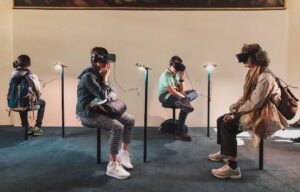Deepfake Technology Examples
Deepfake technology is a rapidly advancing field that uses artificial intelligence and machine learning algorithms to manipulate or generate images, videos, or audio clips that appear authentic but are actually fabricated. With the potential to spread misinformation or defame individuals, it is essential to be aware of deepfake examples in order to detect and combat this emerging threat.
Key Takeaways:
- Deepfake technology uses AI and ML algorithms to create deceptive media.
- Deepfakes can spread misinformation and harm personal reputations.
- Being aware of deepfake examples helps in identifying and combating this threat effectively.
The Rise of Deepfake Technology
In recent years, deepfake technology has gained significant attention due to its realistic fabrication of media content. This technology leverages algorithms to analyze and mimic human behavior to produce highly convincing outputs. *Deepfake technology has the potential to manipulate public opinion and disrupt the understanding of reality.*
Implications of Deepfakes
The implications of deepfakes are both far-reaching and concerning. From political propaganda to identity theft and revenge pornography, deepfakes can be used to defame, deceive, and manipulate unsuspecting individuals or the general public. The consequences of such malicious usage can damage personal lives, institutions, and democracy as a whole. *One intriguing aspect is the ease with which anyone can create deepfakes due to the availability of open-source tools and user-friendly software.*
Examples of Deepfake Technology
Here are some notable examples of deepfake technology:
- **Face-Swapping:** Deepfake algorithms can manipulate facial features to make it seem like one person’s face is seamlessly superimposed onto another’s in videos or images.
- **Voice Cloning:** Deepfake models can mimic someone’s voice by training on a dataset of their speech, enabling the creation of audio clips that sound like the targeted individual.
- **Video Manipulation:** Deepfake videos can alter the context or content of a scene by replacing or overlaying specific objects, changing backgrounds, or even creating entirely new environments.
Deepfake Detection and Mitigation
The fight against deepfakes requires effective detection and mitigation strategies. Researchers and technology companies are actively developing methods to identify and protect against this emerging threat. *One promising avenue is the use of deep learning algorithms to analyze visual and auditory cues that differentiate real content from deepfakes.*
Deepfakes in the Future
As technology advances, deepfake techniques will become even more sophisticated and harder to distinguish from reality. It is crucial to stay informed and utilize the latest advancements in detection and prevention to safeguard against the misuse of this technology. *Understanding the capabilities and limitations of deepfake technology is essential in order to effectively respond to this evolving threat.*
Stay cautious and vigilant in the face of deepfake technology, and remember that not everything you see or hear may be what it appears to be.
| Table 1: Examples of Deepfake Technology |
|---|
| Face-Swapping |
| Voice Cloning |
| Video Manipulation |
| Table 2: Implications of Deepfakes |
|---|
| Spread of misinformation |
| Damage to individual reputation |
| Threat to democracy |
| Table 3: Deepfake Detection and Mitigation |
|---|
| Deep learning algorithms |
| Visual and auditory cues analysis |
| Collaboration between researchers and tech companies |

Common Misconceptions
Deepfake Technology Examples
Deepfake technology has garnered significant attention in recent years, and as a result, several misconceptions have emerged around its capabilities and implications. Here are some common misconceptions surrounding deepfake technology:
- Deepfakes can only be used for malicious purposes: While deepfakes have been associated with the potential for fraudulent activities, such as spreading disinformation or creating non-consensual explicit content, the technology itself is not inherently malicious. Deepfake technology can also be used for legitimate and creative purposes, such as enhancing visual effects in movies or improving facial recognition systems.
- All deepfakes are easily recognizable: It is a widespread misconception that all deepfakes are glaringly obvious and easy to detect. However, this is not necessarily the case, as advancements in machine learning algorithms have made it possible to generate highly realistic deepfakes that are difficult to discern from genuine content. Consequently, relying solely on visual cues may not be sufficient to identify deepfakes accurately.
- Deepfakes can only manipulate video and images: While deepfakes are commonly associated with manipulating videos and images, the technology is not strictly limited to these media types. Deepfake algorithms can also be applied to produce synthetic audio, such as generating speech that mimics the voice of a specific individual. As the technology evolves, deepfakes are likely to expand into different forms of media.
Despite the common misconceptions surrounding deepfake technology, it is crucial to stay informed and understand the implications it poses for society and individuals:
- Understanding the diverse applications of deepfake technology is essential to prevent its misuse and protect individuals from potential harm.
- Developing robust detection techniques is crucial to identify and mitigate the impact of deepfake content, as it becomes increasingly difficult to distinguish real from fake.
- Education and awareness campaigns can help individuals recognize the existence and potential risks associated with deepfakes, promoting responsible consumption of media.
By dispelling these misconceptions and taking proactive steps, it is possible to navigate the evolving landscape of deepfake technology and harness its potential benefits while mitigating its negative consequences.

Introduction
Deepfake technology is a rapidly evolving field that allows for the creation of highly realistic fake videos and images. These manipulated media files have raised concerns about misinformation, privacy, and the potential for malicious use. In this article, we will explore ten examples of deepfake technology and its impact on various aspects of society.
1. Fake Celebrity Interviews
Deepfake technology has been used to create convincing interviews with celebrities, even though they never actually conducted the interview. These videos can deceive the audience into believing that the celebrity made certain statements or endorsed products or ideas they did not.
2. Political Manipulation
Deepfake technology has the potential to influence political campaigns by creating fabricated videos of political candidates saying or doing things they never did. These manipulated videos can be used to spread false narratives or damage one’s reputation.
3. Fake News Reports
Deepfake technology can be employed to create convincing fake news reports that appear to come from reputable sources. These fabricated reports can spread misinformation and confuse the public, contributing to the erosion of trust in journalism.
4. Fraudulent Financial Transactions
Deepfake technology can be used to create fake videos or audio recordings that imitate someone’s voice or appearance, leading to potential fraud in financial transactions. Scammers could create fake recordings of individuals authorizing fraudulent transactions.
5. Misleading Evidence in Legal Cases
Deepfake videos can be created to present false evidence in legal cases. These manipulated videos can deceive judges and juries, potentially leading to wrongful convictions or unjust outcomes.
6. Impersonation and Identity Theft
Deepfake technology can be used to impersonate someone by creating realistic videos or images of them engaging in activities they never participated in. This raises concerns about identity theft and the potential misuse of personal information.
7. Historical Revisionism
Deepfake technology enables the alteration of historical events by creating fake videos or images that depict events differently from reality. This raises concerns about the distortion of history and the potential manipulation of public perception.
8. Revenge Porn and Non-consensual Intimate Content
Deepfake technology can be used to create explicit videos or images featuring individuals without their consent. This phenomenon, known as revenge porn, raises significant privacy concerns and can have severe emotional and psychological repercussions.
9. Entertainment Industry Applications
Deepfake technology is also utilized in the entertainment industry for various purposes, such as replacing actors with digital versions or resurrecting deceased actors for film appearances. These applications raise ethical questions and blur the lines of authenticity.
10. Advancements in Authenticity Verification
While deepfake technology can be harmful, advancements are being made to detect and verify authenticity. Researchers are developing methods and tools to identify manipulated media, providing hope for mitigating the negative consequences of deepfakes.
Through these ten examples, it becomes clear that deepfake technology has profound implications for society. It poses a significant challenge in preserving truth, trust, and privacy. Striking a balance between the development of this technology and ensuring its responsible use is crucial for the future.
Frequently Asked Questions
What are deepfakes?
Deepfakes are synthetic media, typically videos, that are created using deep learning algorithms. These algorithms manipulate existing images or videos, replacing one person’s face with another person’s face, creating highly realistic and often deceptive content.
What are examples of deepfake technology being used?
Examples of deepfake technology being used include creating celebrity pornographic videos, spreading misinformation through manipulated political videos, or even altering historical footage to deceive viewers.
How do deepfakes work?
Deepfakes work by analyzing large amounts of data to create a deep learning model that can accurately replicate facial expressions, movements, and speech patterns of a target person. This model is then used to superimpose the target person’s face onto another person’s body or in a different video.
What risks do deepfakes pose to society?
Deepfakes pose significant risks to society, including the spread of false information, potential damage to reputations, privacy violations, and the potential to manipulate public opinion or interfere in elections.
Are there any positive applications of deepfake technology?
While deepfake technology is primarily associated with negative and potentially harmful consequences, there are some potential positive applications. These include entertainment purposes, such as creating realistic special effects in movies, or for research and educational purposes.
How can I spot a deepfake?
Spotting deepfakes can be challenging, as they are designed to appear highly realistic. However, some signs to watch out for include unnatural facial movements, inconsistent lighting or shadows, glitches around the face, and audio or visual anomalies.
Are there any legal ramifications for creating and sharing deepfakes?
Yes, there can be legal ramifications for creating and sharing deepfakes. Depending on the jurisdiction, the creation and distribution of deepfakes without the consent of the individuals involved can be considered defamation, identity theft, or intellectual property infringement.
What measures are being taken to combat deepfake technology?
Various measures are being taken to combat deepfake technology. These include the development of detection tools and algorithms to identify deepfakes, promoting media literacy to educate the public on recognizing and evaluating manipulated content, and potential regulatory or legislative actions to address the issue.
Can deepfake technology be used for good purposes?
Deepfake technology, if used responsibly and ethically, can have positive applications. For instance, it can be used to create persuasive educational materials, simulate real-life scenarios for training purposes, or bring historical figures to life in an engaging way.
How can individuals protect themselves from falling victim to deepfake technology?
To protect themselves from falling victim to deepfake technology, individuals can be cautious about sharing personal information and media online, verify the authenticity of videos or images from reliable sources, and stay informed about the latest deepfake techniques and detection methods.




